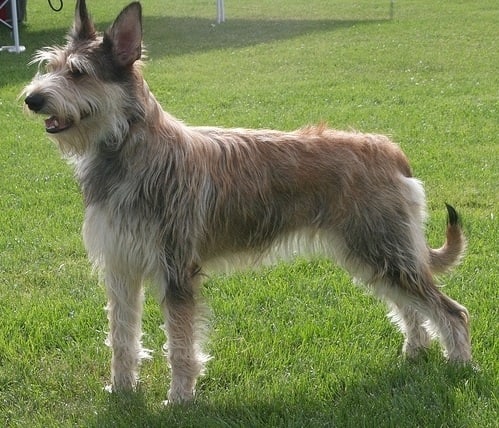The Berger Picard dog is a breed from France, also called the Picardy Shepherd.
This is a rough-coated medium-size dog from the herding dog group. They are recognizable by their distinctive erect ears, standing 4 to 5 inches above their head, and by their long tail with a sharp curve at the end. The Berger Picard dog is a rare breed, with numbers in North America measured in the hundreds. The worldwide population is probably less than 5000.

Berger Picard Dog – Temperament
This is an energetic and enthusiastic breed that loves playing games and taking part in outdoor sports. They are well suited to active owners who can give them enough exercise.
At the same time they have a relaxed and mellow nature, and love being in a family group. They do not bark much, and are suited to apartment life as long as they get enough exercise. But they don’t like being left alone for too long.
Although the Berger was a working dog, they are not hardy against cold temperatures, as they lack the bulk and dense double-layer coat of other herding breeds that keep them warm in cold conditions. This means they are better suited to living indoors, rather than in a kennel in the back yard.
Like most herding dog breeds, this is an intelligent dog, and they pick up training quickly. However they may be suspicious of strangers, and need careful and full socialization over the first 2 years of their lives.

Berger Picard Dog – Breed History
While there is disagreement about the possible origins of this breed, everyone agrees that it is very old. Some believe that the ancestors of the modern Berger were brought to North France by the Gauls (Franks) around the 9th century. Others think that it is related to the Beauceron and Briard.
The 3rd theory states that the Berger Picard is more closely related to the Belgian shepherd dog breeds. Either way, the first documented appearance of a breed called the Berger Picard was at the first French Dog Show in 1863.
Like many breeds, the Berger almost became extinct during the first World War, especially as there was so much trench warfare in their main homeland around the Somme. After the World Wars, dedicate breeders gradually brought the Berger back to sustainable numbers. The breed was recognized by the FCI in 1955, and by the AKC in 2015.
Vital Statistics
Height; 23 inches to 25 inches (male); 21 inches to 23 inches (female).
Weight; 50 lbs to 70 lbs.
Life Span; 12 to 13 years
Color
Brindle; Fawn. Markings – White or Brindle.

Berger Picard Dog – Ease of Training
As an intelligent and smart dog breed, the Berger Picard is not difficult to train. They love games and learning new tricks, and quickly pick up new commands. It’s best to take your Berger to puppy training classes as soon as they are old enough.
At this young age, it’s very important to socialize your Berger, as they can be suspicious of strangers and may become edgy or distrustful. You should introduce your young dog to new and unfamiliar sights, sounds and smells as well as people, under controlled conditions. Check out our page on socializing your puppy HERE.
When they are older, Berger Picard dogs do well in tests and competitions like agility, obedience and flyball. Of course, they do very well in herding events, too!
Berger Picard Dog – Protection
As a watchdog, the Berger is alert and protective of its family. They have an innate distrust of strangers, which they retain even after thorough socialization. So if a potential intruder turns up, the dog will sense their intentions and raise the alarm by barking.
This breed usually doesn’t bark much, so if your Berger starts to bark urgently, you had better go and see what’s up! It’s likely to be something that needs your attention.
On the other hand, the Berger Picard dog is not really big enough to act as an effective guard dog. They simply don’t have the physical presence to intimidate an intruder, nor the weight to take effective action.
The dog will do it’s best to alert its owner of strangers in the vicinity, and to deter them as far as it can; but if you are looking for protection, I recommend you look for a bigger breed.
Berger Picard Dog – Grooming
This is an easy breed to groom, as they do not shed much for most of the time. During their shedding season they should be brushed or combed every couple of days to remove dead hairs. However, the rest of the time they only need a weekly brushing to keep them looking good.
They don’t develop a ‘doggy smell’ much, because they do not have an oily coat (like most water dogs), and only need a bath occasionally, unless they get particularly muddy.
Ears should be checked each week for any signs of infection such as redness, swelling, or a bad smell. Teeth should be brushed every day with a soft, small brush and a dog-specific toothpaste, not a human toothpaste.
The dogs claws should be checked monthly, and trimmed as required if they get too long.
Berger Picard Dog – Health Considerations
This is a breed with very few genetic issues. The National Breed Association recommends screening for hip dysplasia and eye conditions, but that’s about it!
Famous Berger Picard dogs
Berger Picard dogs have been featured in 3 films – ‘Daniel and the Superdogs’ in 2004, ‘Because of Winn-Dixie’ in 2005, and also ‘Are We Done Yet?’ in 2007.



